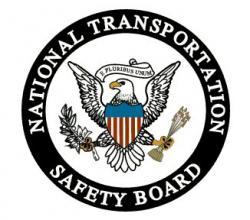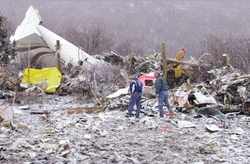Wed, Jun 12, 2002
Busted MDA, Unsent NOTAM Contributed to 18 Deaths
 The National Transportation Safety Board has
determined that the probable cause of an aviation accident in
Aspen, Colorado involving a Gulfstream III was the flight crew's
operation of the airplane below the minimum descent altitude
without visual reference to the runway.
The National Transportation Safety Board has
determined that the probable cause of an aviation accident in
Aspen, Colorado involving a Gulfstream III was the flight crew's
operation of the airplane below the minimum descent altitude
without visual reference to the runway.
Contributing to the accident was the Federal Aviation
Administration's (FAA) unclear wording of a Notice to Airmen
(NOTAM) regarding the nighttime restriction of the VOR/DME-C
approach to the airport. Also cited as contributing factors were
the inability of the flight crew to adequately see the mountain
terrain because of the darkness and weather conditions, the
pressure from the charter customers for the captain to land the
airplane, and the delayed departure of the airplane from
California, causing the flight to arrive at sunset during the
airport's nighttime landing restrictions.
On March 29, 2001, a Gulfstream III owned by Airbourne Charter,
Inc. and operated by Avjet Corporation of Burbank, California, with
15 passengers, 2 pilots and 1 flight attendant, crashed on final
approach to runway 15 at Aspen-Pitkin County Airport (ASE). The
airplane crashed into sloping terrain about 2,400 feet short of the
runway threshold. All persons aboard the aircraft died.
The Safety Board's investigation determined the following
facts:
 (1) the flight crew descended below the minimum
descent altitude even though the airplane maneuvers and comments on
the cockpit voice recorder indicated that neither pilot had
established nor maintained visual contact with the runway or its
environment;
(1) the flight crew descended below the minimum
descent altitude even though the airplane maneuvers and comments on
the cockpit voice recorder indicated that neither pilot had
established nor maintained visual contact with the runway or its
environment;
(2) the flight crew did not discuss a missed approach after
receiving a third report of a missed approach to the airport and a
report of deteriorating visibility in the direction of the approach
course; and
(3) a copy of the FAA issued NOTAM on March 20, 2001, stating
"circling not authorized at night for runway 15 at Aspen" had not
been sent to the Aspen tower.
Without knowledge of the NOTAM, the approach controller cleared the
flight crew for the VOR/DME-C instrument approach procedure.
Following the accident, the FAA became concerned about potential
pilot confusion regarding the wording of the NOTAM -- specifically,
that pilots might infer that straight-in landings to runway 15 were
authorized at night. On March 30, 2001, a revised NOTAM was issued
stating, "procedure not authorized at night."
In light of the fact that in mountainous terrain night conditions
can exist prior to sunset due to the geography and ambient lighting
conditions, the Safety Board issued an emergency Safety
Recommendation on April 15, 2002 asking the FAA to:
"Revise any restrictions and prohibitions that currently reference
or address 'night' or 'nighttime' flight operations in mountainous
terrain so that those restrictions and prohibitions account for the
entire potential period of darkness or insufficient ambient light
conditions, and establish a method to clearly communicate to flight
crews when such restrictions and prohibitions apply.
Following Tuesday's Board meeting, the Safety Board made the
following recommendation to the FAA:
 Revise 14 Code of Federal Regulations Part 135 to
require on-demand charter operations that conduct operations with
aircraft requiring two or more pilots to establish a Federal
Aviation Administration approved crew resource management training
program for their flight crews in accordance with 14 CFR Part 121,
subparts N and O.
Revise 14 Code of Federal Regulations Part 135 to
require on-demand charter operations that conduct operations with
aircraft requiring two or more pilots to establish a Federal
Aviation Administration approved crew resource management training
program for their flight crews in accordance with 14 CFR Part 121,
subparts N and O.
More News
NORDO (No Radio) Aircraft that cannot or do not communicate by radio when radio communication is required are referred to as “NORDO.”>[...]
Aero Linx: South Carolina Aviation Association (SCAA) Airports in South Carolina support the state’s economy and are themselves economic generators. Residents, businesses, an>[...]
Also: AV-8B Harrier For CAF Arizona, Boeing Gets ODA, Army NG Rescue, Longitude To C. America A California Superior Court judge recently ruled that GAMI’s unleaded avgas does>[...]
Also: Williams International Builds Up, Marines v Drones, NBAA v Tariffs, New GAMA Members Hermeus confirmed the flight of its Quarterhorse MK 1 aircraft at the Air Force Test Cent>[...]
A Few Questions AND Answers To Help You Get MORE Out of ANN! 1) I forgot my password. How do I find it? 1) Easy... click here and give us your e-mail address--we'll send it to you >[...]
 ANN's Daily Aero-Term (06.04.25): NORDO (No Radio)
ANN's Daily Aero-Term (06.04.25): NORDO (No Radio) ANN's Daily Aero-Linx (06.04.25)
ANN's Daily Aero-Linx (06.04.25) Airborne 06.04.25: G100UL Legal Decision, FAA v Starship, Laser Conviction
Airborne 06.04.25: G100UL Legal Decision, FAA v Starship, Laser Conviction Airborne-NextGen 06.03.25: Hermeus Quarterhorse, VFS Forum, VX4 eVTOL
Airborne-NextGen 06.03.25: Hermeus Quarterhorse, VFS Forum, VX4 eVTOL ANN FAQ: Q&A 101
ANN FAQ: Q&A 101





